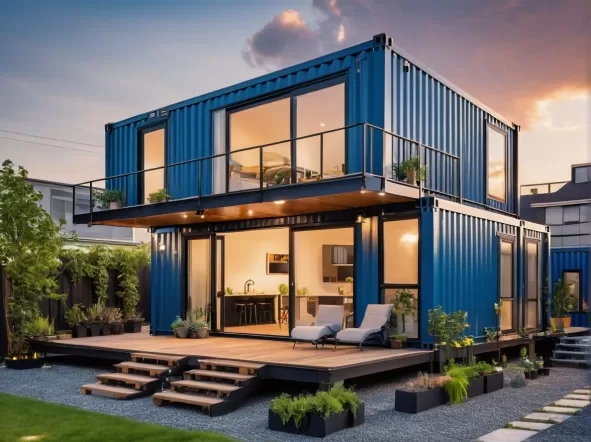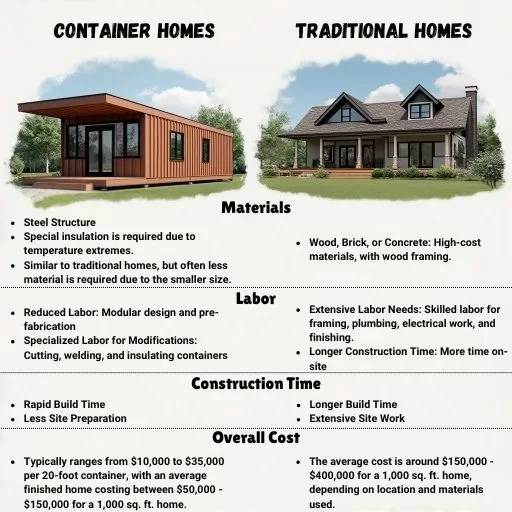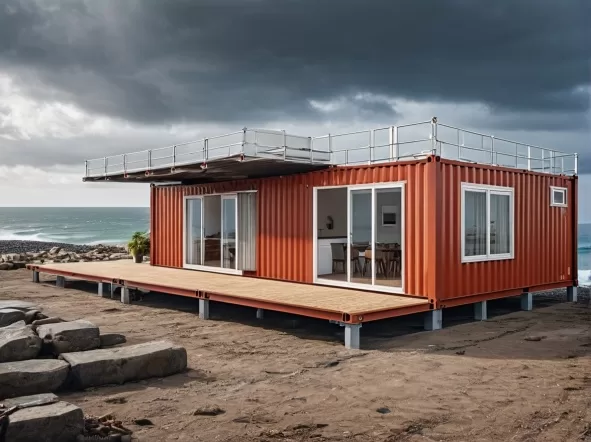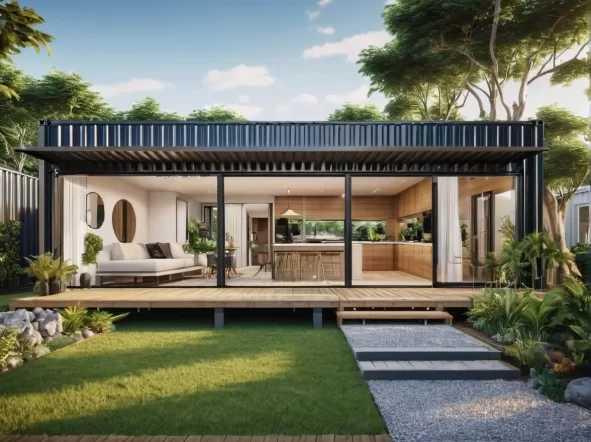Container Homes vs. Traditional Homes – All You Need to Know

The housing market has evolved dramatically over the past few decades, with innovative, sustainable, and cost-effective housing solutions becoming increasingly popular. One of the most intriguing and rapidly growing trends is container homes, a creative approach to homebuilding that repurposes shipping containers into livable spaces. But how do these unconventional dwellings stack up against traditional homes? Are they just a fad, or do they represent the future of affordable, sustainable housing? In this blog post, we will dive deep into the world of container homes, comparing them with traditional homes across various aspects like cost, sustainability, durability, and design flexibility.
Introduction
Container houses have been making waves in the architectural world, capturing the imagination of eco-conscious homeowners, architects, and builders alike. These houses are not just about reusing materials; they represent a broader shift towards minimalist, sustainable living. Traditional houses, on the other hand, are what we all know—built with bricks, wood, and concrete, and deeply rooted in history and familiarity.
1. What Are Container Homes?
Container homes are residences built using steel shipping containers, originally designed for transporting goods across the globe. These containers are often available in standard sizes (typically 20 or 40 feet long, 8 feet wide, and 8.5 to 9.5 feet tall). While they were not initially designed for human habitation, innovative designers and builders have found ways to transform them into stylish, functional, and comfortable living spaces.
According to recent data, there are approximately 17 million shipping containers globally, and only 6 million are in use, leaving around 11 million sitting unused. This surplus has spurred the growth of container homes, offering a solution to both environmental concerns and housing shortages.
2. Cost Comparison: Container Homes vs. Traditional Homes
One of the most compelling reasons people consider container houses is the potential for significant cost savings. The price of a container home can vary widely depending on factors such as location, size, and level of customization. However, on average, a basic container home can cost between $10,000 to $35,000, while a fully customized, high-end container home can range from $100,000 to $175,000. Relocating a container can be costly and consume a significant portion of your budget before you begin construction. This is especially true when you need to transport the container over long distances. It is preferable to shop locally whenever possible.
In contrast, traditional homes in the U.S. have an average cost of around $150 to $250 per square foot, making a 2,000-square-foot home approximately $300,000 to $500,000. These costs can skyrocket in urban areas or when adding luxury finishes.
a. Building Time and Labor Costs
Container homes are generally quicker to build than traditional homes, often taking just a few weeks to a few months, depending on complexity. This is partly due to the modular nature of containers and the reduced need for extensive foundation work. In comparison, traditional homes can take anywhere from six months to over a year to complete.
The faster construction timeline translates to lower labor costs. According to a study by the National Association of Home Builders, labor accounts for nearly 20% of the total cost of building a traditional home. In container homes, this percentage is often lower, providing additional savings.

3. Sustainability and Environmental Impact
The environmental benefits of container homes are one of their biggest selling points. Repurposing used shipping containers helps reduce waste, and the steel structure of the containers means fewer new materials are needed. Additionally, container homes can be designed to be highly energy-efficient, incorporating features like solar panels, rainwater harvesting systems, and eco-friendly insulation.
According to the U.S. Environmental Protection Agency, using recycled steel, such as that found in shipping containers, can reduce CO2 emissions by 30% compared to new steel production. In traditional home construction, materials like concrete and brick have high embodied energy, meaning they require significant energy to produce and transport, contributing to a larger carbon footprint.
a. Insulation and Energy Efficiency
One concern often raised about container homes is insulation. Steel is a great conductor of heat, meaning it can get extremely hot in summer and very cold in winter. However, with proper insulation—using spray foam, rock wool, or other eco-friendly materials—container homes can achieve excellent thermal performance.
Traditional homes, particularly those built with modern techniques, can also be energy-efficient, especially when utilizing high-quality windows, proper insulation, and energy-efficient appliances. However, achieving these efficiencies often comes at a higher cost compared to the relatively straightforward upgrades possible in container homes.
4. Durability and Maintenance
Container homes are incredibly durable, thanks to their robust steel construction designed to withstand harsh weather conditions during shipping. They are resistant to mold, pests, and fire, which are common concerns in traditional homes. A well-maintained container home can last over 25 years without significant structural issues, and with proper care, they can last even longer.
Traditional homes, while also durable, are subject to wear and tear that can vary significantly based on the materials used, the quality of construction, and local weather conditions. For example, wooden homes may suffer from termite infestations, rot, or warping over time, requiring regular maintenance and sometimes costly repairs.
a. Weather Resistance
One notable advantage of container homes is their ability to withstand extreme weather conditions, including hurricanes and earthquakes, better than many traditional homes. Their low center of gravity and sturdy frame make them more resistant to natural disasters, provided they are properly anchored.
Traditional homes, depending on their construction, may be more vulnerable to extreme weather events, especially older homes that don’t meet modern building codes.

5. Design Flexibility and Aesthetics
When it comes to design, container homes offer a unique aesthetic that appeals to those who love modern, industrial looks. The boxy shape of containers may seem limiting, but creative architects have proven otherwise, designing homes that are both stunning and functional. Container homes can be stacked, arranged, and modified to create multi-story structures, cantilevers, and open-plan interiors that rival the best of modern architecture.
However, traditional homes have the advantage of familiarity and versatility in design. From colonial to contemporary, ranch to Victorian, traditional homes can be customized to fit almost any architectural style, which often appeals to those looking for a more conventional appearance.
a. Space and Layout Challenges
One of the challenges of container homes is working within the constraints of the container’s dimensions. Standard containers are relatively narrow, which can make designing wide, open spaces more challenging without significant modifications, such as removing walls or adding extensions.
Traditional homes, by comparison, offer greater flexibility in terms of layout and room sizes, making them a more suitable option for families or those needing larger living spaces.

6. Resale Value and Market Perception
One of the most critical factors in choosing between container homes and traditional homes is their resale value. Traditional homes have a well-established market, with clear valuation metrics based on location, size, and condition. They tend to appreciate over time, making them a safer investment.
Container homes, on the other hand, are relatively new to the real estate market. While they appeal to a niche audience, their resale value can be unpredictable, and finding buyers may take longer, especially in areas where container homes are less common.
a. Zoning and Permits
It’s also important to note that container homes may face zoning and permit challenges, as some local governments are still catching up with the trend. Depending on where you live, there might be restrictions on building with shipping containers, which can impact your ability to build or sell.
Conclusion
Choosing between container homes and traditional homes ultimately depends on your lifestyle, budget, and values. Container homes offer an eco-friendly, cost-effective, and fast alternative to traditional construction, appealing to those who prioritize sustainability and modern design. However, they come with their own set of challenges, including limited space, potential insulation issues, and uncertain resale value.
Traditional homes, while generally more expensive and less environmentally friendly, provide familiarity, market stability, and broader design options that can suit a wide range of tastes and needs.
